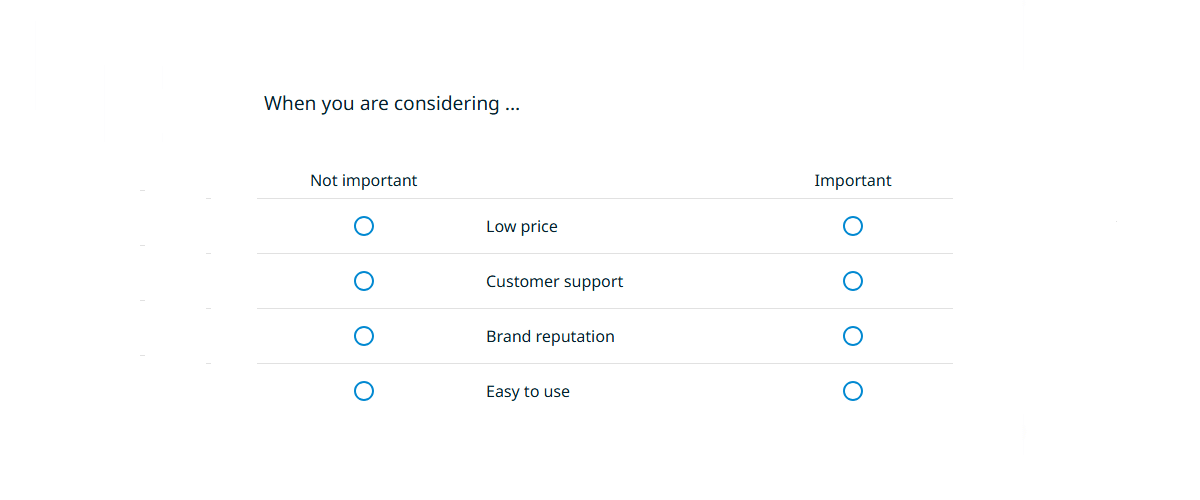The modern world of market research offers a wide range of tools to better understand customer needs and expectations. Among these, MaxDiff (Maximum Difference Scaling), also known as Best-Worst Scaling, holds a special place. It is a technique that allows for precise and reliable measurement of respondent preferences – even when dealing with large lists of features, products, or marketing messages. Thanks to its simplicity and efficiency, MaxDiff has gained popularity in marketing research, UX studies, communication testing, and customer segmentation.
What is MaxDiff?
In a MaxDiff study, respondents are presented with sets (called “tasks”) containing several (typically 4–6) items selected from a larger list. For each set, the respondent chooses the most and least appealing option (i.e., the “best” and “worst”). This process is repeated across different combinations of items.
Example: Imagine we want to find out which features of a mobile phone are most important to customers. The list includes battery life, camera quality, processing speed, price, brand, screen size, etc. Instead of asking respondents to rate each feature on a scale (e.g., 1 to 5), we present them with sets of 4 features and ask which one is most important and which one is least important. Based on many such choices, we build a preference ranking.
Advantages of MaxDiff
1. Greater precision than traditional rating scales:
Respondents struggle to evaluate many items using traditional scales like Likert. Scores often cluster or become indistinguishable. MaxDiff forces respondents to make real trade-offs, leading to more thoughtful decisions.
2. Elimination of scale bias:
In rating scales, different respondents interpret values differently (e.g., a “4” might mean “good” to one person and “very good” to another). MaxDiff relies on relative comparisons, eliminating this inconsistency.
3. Suitable for long lists:
Studies show MaxDiff handles long lists of 20–30 items better than traditional methods, which often lead to respondent fatigue.
4. Scaled, easy-to-interpret results:
MaxDiff provides results as preference scores (e.g., on a 0 to 100 scale), with each item assigned a number reflecting its relative appeal.
Disadvantages and Limitations
1. Higher analytical demands:
Analyzing MaxDiff data requires statistical methods such as logit regression, Bayesian analysis, or hierarchical models. This is more complex than simply averaging ratings.
2. Lack of absolute importance information:
MaxDiff tells you what’s more important relative to other items, but not how important each feature is in absolute terms. This can be supplemented with additional survey questions if needed.
3. Limited number of items per task:
Too many items in one task make comparisons difficult. Therefore, tasks usually include only 4–6 items.
Applications of Max-Diff
1. Testing marketing messages:
Which advertising slogans are most persuasive? MaxDiff helps identify top-performing messages.
2. Understanding customer needs and expectations:
Helps assess which product or service features are most important across customer segments.
3. Persona building and market segmentation:
MaxDiff supports more accurate customer segmentation based on real preferences rather than self-declared importance.
4. Testing concepts and offers:
If a company is considering several offer variants, MaxDiff can help determine which combinations are most appealing to customers.
MaxDiff is often compared with conjoint analysis. Both methods aim to uncover customer preferences but differ in approach. Conjoint evaluates entire product configurations (e.g., combinations of features), while MaxDiff focuses on individual attributes. Therefore, MaxDiff is better suited when the goal is to understand the importance of standalone features rather than how they interact.
Conclusion
MaxDiff is an effective and precise research method that delivers reliable insights into customer preferences. Its design avoids common pitfalls of traditional rating scales, offering results that are easier to interpret and more actionable for business decisions. While the analysis may require more advanced statistical knowledge, the value of the insights gained far outweighs the technical complexity. In a business environment increasingly driven by data, Max-Diff is a powerful tool in any market researcher’s arsenal.
